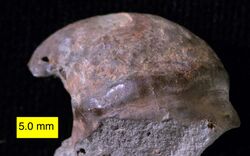Biology:Platyceras
| Platyceras | |
|---|---|

| |
| Platyceras pulcherrimum from the Logan Formation (Mississippian) of Wooster, Ohio) | |
| Scientific classification | |
| Kingdom: | |
| Phylum: | |
| Class: | |
| (unranked): | clade Neritimorpha
|
| Superfamily: | Platyceratoidea
|
| Family: | |
| Genus: | Platyceras Conrad, 1840
|
| Synonyms | |
| |

Platyceras is a genus of extinct Paleozoic sea snails, marine gastropod mollusks in the family Platyceratidae. This genus is known from the Silurian to the Middle Triassic periods and especially abundant in the Devonian and Carboniferous.[1] It is the type genus of the family Platyceratidae.
Description
Platyceras has a distinctive, curved conical shape that is easily recognized. The cap-like shell is high and broad anteriorly. The posterior portion of the shell, at the apex, is usually slightly coiled in an asymmetrical fashion. Frequently, the front portions of the shells are broken, though the posterior sections are relatively well preserved. Platyceras is particularly abundant in Devonian deposits (359 million to 416 million years old).[1] Platyceras and other platyceratid gastropods are known for the complex symbiotic relationships they had with crinoids.[2]
Distribution
Fossils of Platyceras have been found all over the world,[1] among others in the Silurian Bertie Formation of Ontario and New York and the Devonian Floresta Formation of Boyacá, Colombia.[3]
References
- ↑ 1.0 1.1 1.2 Paleobiology Database. Platyceras at Fossilworks.org
- ↑ Baumiller T. K. (2003). "Evaluating the interaction between platyceratid gastropods and crinoids; a cost-benefit approach". Palaeogeography, Palaeoclimatology, Palaeoecology 201(3-4): 199-209. doi:10.1016/S0031-0182(03)00625-4.
- ↑ Mojica & Villarroel, 1984, pp.65-69
- T. A. Conrad. 1840. Third annual report on the palaeontological department of the survey. New York Geological Survey, Annual Report 4(1):199-207
Bibliography
- Mojica, Jairo, and Carlos Villarroel A. 1984. Contribución al conocimiento de las unidades paleozoicas del área de Floresta (Cordillera Oriental Colombiana; Departamento de Boyacá) y en especial al de la Formación Cuche. Geología Colombiana 13. 55-80. Accessed 2017-03-31.
Wikidata ☰ Q2689745 entry
 |

